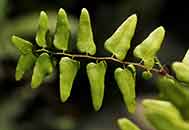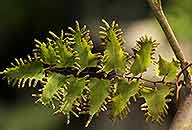Lygodium microphyllum (Cav.) R. Br.
Synonyms |
Ugena microphylla Cav. |
|---|---|
Common name |
|
Description |
Rhizome creeping, 3 mm in diameter, subterranean; rhizome scales linear, blackish-brown, ± 1.5 mm long. Fronds herbaceous, spaced 4–13 cm apart, 3–10 m long, 20–40 cm wide. Stipe and rhachis of an elongated frond function as the climbing stem, from which short secondary rhachises with an opposing pair of pinnae arise, apical bud densely covered with short brown hairs 1-4 mm long. Pinnae oblong, pinnate, glabrous. Sterile pinnules 0.5–6.2 x 1–2.3 cm, petiolate, articulated, lanceolate to oblong-lanceolate in outline, base cordate, apex acute to rounded, margins minutely lobed, veins free. Fertile pinnules 1–7.5 x 0.6–2.5 cm, broadly lanceolate to oblong in outline, apex acute or acuminate to rounded, base square, glabrous, margin minutely crenate, with numerous protuding linear fertile lobes, 1–12 x 1–1.5 mm; sporangia 10-12 pairs, arranged in 2 rows along the margins. |
Notes | According to J.E.Burrows (1990), Schelpe (1970) and Roux (2009) not in Zimbabwe, only close to the coast in Mozambique and South Africa.
|
Derivation | microphyllum: small-leaved; unclear reference, no parts of the frond are smaller than that of other Lygodium species. |
Habitat | Moist conditions along the margins of evergreen montane and riverine forest. |
Distribution worldwide | Africa, Asia, Australia and Polynesia. |
Distribution in Africa |
Angola, Benin, Burundi, Cameroon, Central African Republic, Chad, Congo, Dem. Republic of Congo, Equatorial Guinea (incl. Bioko), Gabon, Gambia, Ghana, Guinea, Guinea Bissau, Ivory Coast, Kenya, Liberia, Malawi, Mali, Mozambique, Nigeria, Senegal, Sierra Leone, South Africa, Sudan and South Sudan, Tanzania , Zambia, Zimbabwe. |
Growth form |
Climbing, terrestrial. |
Literature |
|



